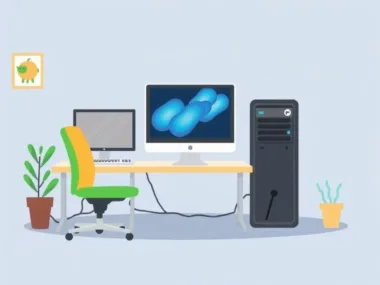Understanding the key differences between workstation and desktop computers is essential for users. This guide explores hardware, performance, cost, and usage scenarios, helping you choose the right computer for your needs and budget. Discover whether a versatile desktop or a high-performance workstation is best for you.
Understanding the Key Difference between Workstation and Desktop Computer
Ever wondered why your colleague’s computer seems to handle complex tasks with ease while yours struggles with basic applications? The answer might lie in the type of computer they’re using. In the world of computing, two terms often come up: workstation and desktop. While they might look similar at first glance, these machines serve different purposes and are built for distinct types of users. Whether you’re a professional handling intensive tasks or an everyday user browsing the web, understanding the difference between a workstation and a desktop computer is crucial for making the right choice.
This guide dives deep into the key differences between workstations and desktops, covering everything from hardware and performance to cost, usage scenarios, and more. By the end, you’ll have a clear picture of which one suits your needs—and your budget.
What Is a Desktop Computer?
A desktop computer is a personal computer designed for regular use at a single location, typically consisting of a monitor, keyboard, mouse, and a central processing unit (CPU). Desktops are the go-to choice for most home and office users because they’re versatile, affordable, and capable of handling everyday tasks like:
- Web browsing
- Word processing
- Email management
- Light gaming
- Streaming media
Desktops come in various forms, from compact all-in-one models to customizable towers. They’re built with general-purpose hardware that balances performance and cost, making them accessible to the average consumer.
What Is a Workstation?
A workstation is a high-performance computer designed for professional and technical work. Unlike desktops, workstations are tailored for tasks that demand significant computational power, such as:
- Graphic design and 3D rendering
- Video editing and animation
- Scientific simulations
- Engineering and architectural design
- Data analysis and machine learning
Workstations are equipped with specialized hardware—like multi-core processors, high-end graphics cards, and large amounts of RAM—to handle these resource-intensive applications efficiently. They’re the Ferraris of the computing world: powerful, precise, and built for speed.
Key Differences Between Workstations and Desktops
While both workstations and desktops are computers, they differ significantly in several areas. Let’s break down the most important distinctions:
1. Hardware
- Processors (CPUs): Desktops typically use consumer-grade CPUs with 4 to 8 cores, sufficient for everyday multitasking. Workstations, however, often feature server-grade or multi-core processors (e.g., Intel Xeon or AMD Ryzen Threadripper) with 16 to 64 cores, enabling them to handle complex calculations and parallel processing.
- Memory (RAM): A standard desktop might have 8 to 16 GB of RAM, while workstations can pack 64 GB to 1 TB or more. This extra memory allows workstations to manage large datasets and run memory-intensive applications without slowing down.
- Graphics Cards (GPUs): Desktops usually come with consumer GPUs for gaming or basic graphics. Workstations use professional-grade GPUs (e.g., NVIDIA Quadro or AMD Radeon Pro) optimized for rendering, simulations, and design work.
- Storage: Workstations often include faster storage solutions like NVMe SSDs or RAID configurations for speed and redundancy, while desktops might rely on standard SSDs or HDDs.
- Specialized Components: Workstations may also feature ECC (Error-Correcting Code) memory, which detects and fixes data corruption—crucial for tasks where accuracy is non-negotiable, like scientific computing or financial modeling.
2. Performance
- Desktops: Built for general use, desktops handle everyday tasks efficiently but may struggle with resource-heavy applications like 3D rendering or video editing.
- Workstations: Engineered for peak performance, workstations excel at multitasking and processing large amounts of data. They’re designed to run demanding software smoothly, making them indispensable for professionals in fields like engineering, animation, and data science.
Analogy: If a desktop is like a family sedan—reliable for daily errands—a workstation is like a high-performance sports car, built for speed, precision, and heavy-duty tasks.
3. Usage Scenarios
- Desktops: Ideal for:
- Home and office use
- Students and casual users
- Light gaming and media consumption
- Small businesses with basic computing needs
- Workstations: Best suited for:
- Graphic designers and video editors
- Engineers and architects
- Scientists and researchers
- Financial analysts and data scientists
Example: A graphic designer might use a workstation to render 4K animations in minutes, while a student might use a desktop for writing papers and streaming lectures.
4. Cost
- Desktops: Generally affordable, with prices ranging from $300 to $1,500 for mid-range models. High-end gaming desktops can go up to $3,000, but they’re still less expensive than workstations.
- Workstations: Start at around $1,500 and can easily exceed $5,000 for top-tier models with specialized hardware. The cost reflects the premium components and performance capabilities.
Tip: If you’re on a budget and don’t need extreme performance, a desktop is the way to go. But if your work demands power, a workstation is a worthwhile investment.
5. Software
- Desktops: Typically come with consumer operating systems like Windows or macOS, and users install software as needed.
- Workstations: Often pre-installed with professional software suites (e.g., AutoCAD for engineers or Adobe Creative Cloud for designers) optimized for their hardware. This can save time and ensure compatibility.
6. Upgradability
- Desktops: Highly customizable and easy to upgrade. Users can swap out components like RAM, storage, or graphics cards with relative ease.
- Workstations: While some components can be upgraded, workstations often have more limited options due to their specialized hardware and proprietary designs. Upgrading might require professional assistance.
7. Design and Aesthetics
- Desktops: Available in a wide range of designs, from sleek all-in-ones to customizable RGB-lit towers. Aesthetics often cater to consumer preferences.
- Workstations: Prioritize functionality over form, with a more utilitarian, industrial look. They’re built for performance, not style, and often feature robust cooling systems and expandable chassis.
Which One Is Right for You?
Choosing between a workstation and a desktop depends on your specific needs and budget. Here’s a quick guide:
- Choose a Desktop if:
- You need a computer for everyday tasks like browsing, office work, or light gaming.
- You’re on a budget and don’t require extreme performance.
- You value upgradability and a wide range of design options.
- Choose a Workstation if:
- You’re a professional handling resource-intensive tasks like 3D rendering, video editing, or scientific simulations.
- You need specialized hardware and software for your work.
- You’re willing to invest in a high-performance machine that can handle demanding applications.
Conclusion
Workstations and desktops may share a similar appearance, but they’re built for different worlds. Desktops are the versatile, budget-friendly choice for everyday users, while workstations are the powerhouse machines designed for professionals who demand top-tier performance. By understanding the differences in hardware, performance, usage, cost, and more, you can make an informed decision that aligns with your needs.
Whether you’re upgrading your home office or outfitting a design studio, the right choice will keep you productive—and maybe even save you from a few headaches along the way.














Leave a Reply